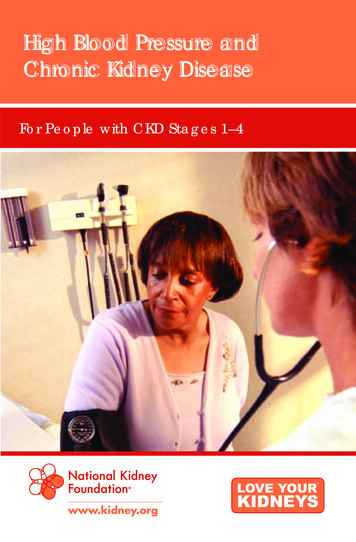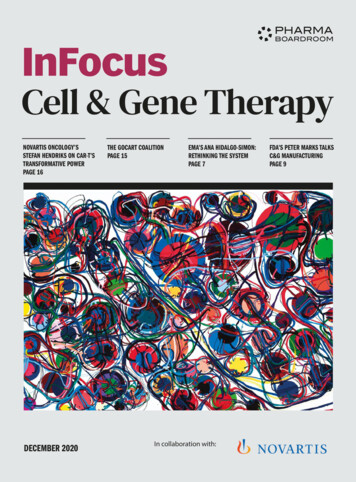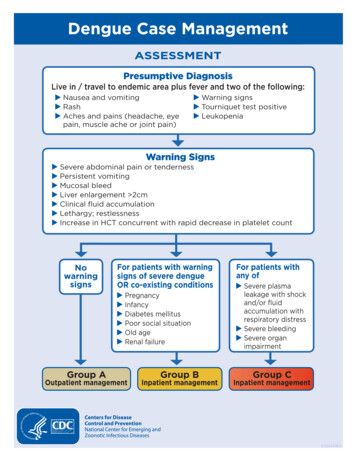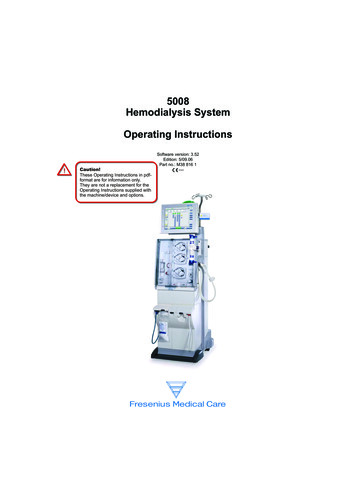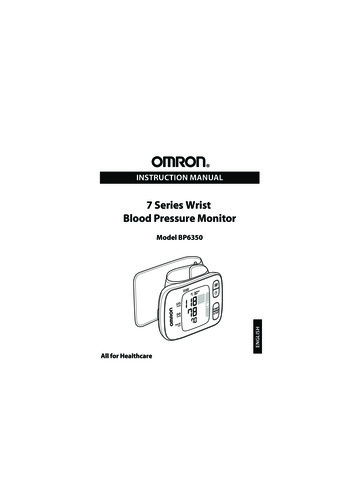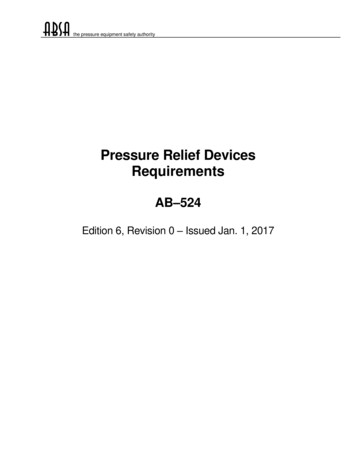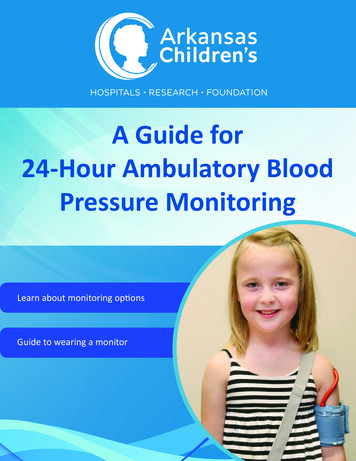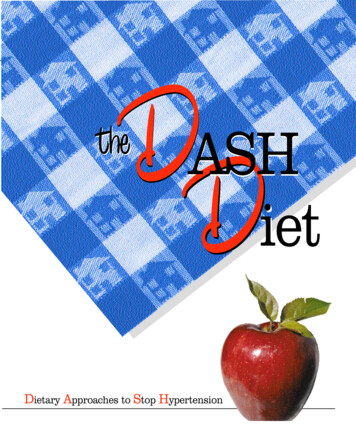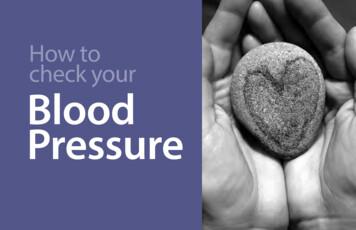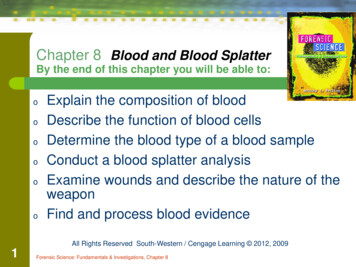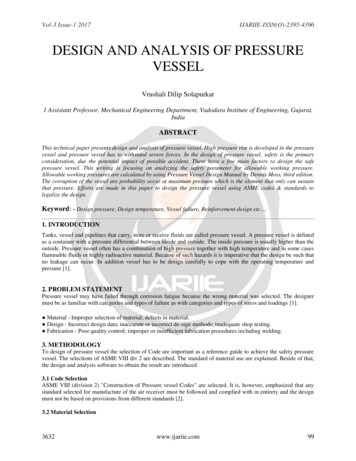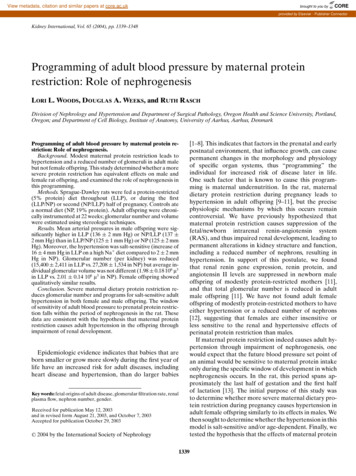
Transcription
View metadata, citation and similar papers at core.ac.ukbrought to you byCOREprovided by Elsevier - Publisher ConnectorKidney International, Vol. 65 (2004), pp. 1339–1348Programming of adult blood pressure by maternal proteinrestriction: Role of nephrogenesisLORI L. WOODS, DOUGLAS A. WEEKS, and RUTH RASCHDivision of Nephrology and Hypertension and Department of Surgical Pathology, Oregon Health and Science University, Portland,Oregon; and Department of Cell Biology, Institute of Anatomy, University of Aarhus, Aarhus, DenmarkProgramming of adult blood pressure by maternal protein restriction: Role of nephrogenesis.Background. Modest maternal protein restriction leads tohypertension and a reduced number of glomeruli in adult malebut not female offspring. This study determined whether a moresevere protein restriction has equivalent effects on male andfemale rat offspring, and examined the role of nephrogenesis inthis programming.Methods. Sprague-Dawley rats were fed a protein-restricted(5% protein) diet throughout (LLP), or during the first(LLP/NP) or second (NP/LLP) half of pregnancy. Controls atea normal diet (NP, 19% protein). Adult offspring were chronically instrumented at 22 weeks; glomerular number and volumewere estimated using stereologic techniques.Results. Mean arterial pressures in male offspring were significantly higher in LLP (136 2 mm Hg) or NP/LLP (137 2 mm Hg) than in LLP/NP (125 1 mm Hg) or NP (125 2 mmHg). Moreover, the hypertension was salt-sensitive (increase of16 4 mm Hg in LLP on a high Na diet compared to 2 2 mmHg in NP). Glomerular number (per kidney) was reduced(15,400 2,411 in LLP vs. 27,208 1,534 in NP) but average individual glomerular volume was not different (1.98 0.18 106 l3in LLP vs. 2.01 0.14 106 l3 in NP). Female offspring showedqualitatively similar results.Conclusion. Severe maternal dietary protein restriction reduces glomerular number and programs for salt-sensitive adulthypertension in both female and male offspring. The windowof sensitivity of adult blood pressure to prenatal protein restriction falls within the period of nephrogenesis in the rat. Thesedata are consistent with the hypothesis that maternal proteinrestriction causes adult hypertension in the offspring throughimpairment of renal development.Epidemiologic evidence indicates that babies that areborn smaller or grow more slowly during the first year oflife have an increased risk for adult diseases, includingheart disease and hypertension, than do larger babiesKey words: fetal origins of adult disease, glomerular filtration rate, renalplasma flow, nephron number, gender.Received for publication May 12, 2003and in revised form August 21, 2003, and October 7, 2003Accepted for publication October 29, 2003 C2004 by the International Society of Nephrology[1–8]. This indicates that factors in the prenatal and earlypostnatal environment, that influence growth, can causepermanent changes in the morphology and physiologyof specific organ systems, thus “programming” theindividual for increased risk of disease later in life.One such factor that is known to cause this programming is maternal undernutrition. In the rat, maternaldietary protein restriction during pregnancy leads tohypertension in adult offspring [9–11], but the precisephysiologic mechanisms by which this occurs remaincontroversial. We have previously hypothesized thatmaternal protein restriction causes suppression of thefetal/newborn intrarenal renin-angiotensin system(RAS), and thus impaired renal development, leading topermanent alterations in kidney structure and function,including a reduced number of nephrons, resulting inhypertension. In support of this postulate, we foundthat renal renin gene expression, renin protein, andangiotensin II levels are suppressed in newborn maleoffspring of modestly protein-restricted mothers [11],and that total glomerular number is reduced in adultmale offspring [11]. We have not found adult femaleoffspring of modestly protein-restricted mothers to haveeither hypertension or a reduced number of nephrons[12], suggesting that females are either insensitive orless sensitive to the renal and hypertensive effects ofperinatal protein restriction than males.If maternal protein restriction indeed causes adult hypertension through impairment of nephrogenesis, onewould expect that the future blood pressure set point ofan animal would be sensitive to maternal protein intakeonly during the specific window of development in whichnephrogenesis occurs. In the rat, this period spans approximately the last half of gestation and the first halfof lactation [13]. The initial purpose of this study wasto determine whether more severe maternal dietary protein restriction during pregnancy causes hypertension inadult female offspring similarly to its effects in males. Wethen sought to determine whether the hypertension in thismodel is salt-sensitive and/or age-dependent. Finally, wetested the hypothesis that the effects of maternal protein1339
1340Woods et al: Prenatal protein restriction and adult hypertensiondeprivation to increase offspring blood pressure may berelated to its effects on nephrogenesis.METHODSFemale Sprague-Dawley rats (Simonsen, Gilroy, CA,USA) weighing 250 to 300 g were bred at OregonHealth & Science University (OHSU) and maintained oneither a normal protein (NP, 19% protein) (Purina basaldiet 5755), or a low protein (LLP, 5% protein) (Purina5767, modified from 5755) (Purina, Richmond, IN, USA)diet ad libitum during specific time windows in pregnancyand lactation. The two diets were isocaloric and had thesame Na content (0.20%). Dams were kept on the NPdiet before breeding. The day sperm were seen in a vaginal smear was designated as day 1 of pregnancy. Onegroup of dams was maintained on NP throughout pregnancy and lactation (NP, control group). A second groupof dams was placed on LLP on day 1 of pregnancy, andswitched to NP on day 11 of pregnancy (LLP/NP). A thirdgroup of dams was maintained on NP until day 11 of pregnancy, when they were placed on LLP (NP/LLP). Theywere then returned to the NP diet the day of delivery. Afourth group of dams was maintained on LLP throughoutpregnancy and switched to NP the day of delivery. Foodintake was not significantly different among the groups,either during the first or last half of pregnancy, or throughout pregnancy. No dams were maintained on LLP afterdelivery because of concerns that pup survival would bejeopardized. Thus, the third and fourth groups were exposed to maternal protein restriction during the prenatalportion of the window of nephrogenesis, whereas the firstand second groups were not. All pups were weaned to thenormal diet at 22 days of age and maintained on that dietuntil adulthood. The animals were housed in a room witha controlled temperature and a 12:12 hour light:dark cycle. Some newborn animals were used for histologic analysis of renal tissue; littermates were allowed to grow untiladulthood for physiologic measurements. Some LLP andNP pregnant animals were euthanized at 23 days’ gestation for collection of fetal kidneys.Collection of fetal and newborn tissuesFetal and newborn kidneys were collected at 23 days’gestation and 1 to 15 days of postnatal age for examination of renal histology. They were fixed in 10% phosphatebuffered formalin, embedded in paraffin, and 5lmsections were stained with hematoxylin and eosin.Surgical preparation of adult animalsAt approximately 21 weeks of age, adult male and female animals were chronically instrumented for measurements of arterial pressure and renal function as describedpreviously [11]. Briefly, they were anesthetized with amixture of 55% ketamine (100 mg/mL), 28% xylazine(20 mg/mL), 11% acepromazine (10 mg/mL), and 6%sterile water, administered at 1.0 mL/kg intraperitoneally.A stainless steel Silastic-covered catheter was implantedin the bladder, flushed with chloramphenicol sodium succinate (30 mg/mL), and plugged. Sterile catheters madeof Tygon microbore tubing were implanted into the leftfemoral artery and vein and tunneled under the skinto exit on top of the head. The catheters were filledwith heparin (500 U/mL) following surgery, and pluggedwith stainless steel wire pins. For the first 24 hours after surgery, a mixture of rat chow and 5% dextrose wasprovided in a bowl to encourage eating. Animals wereallowed to recover in individual cages for at least 6 daysbefore any experiments were conducted and were maintained on the normal protein, normal sodium diet. Vascular catheters were flushed every 2 or 3 days to maintainpatency. During the recovery period, the animals wereplaced in a wire restrainer in the study room for at least2 hours on at least three occasions to allow them to become acclimatized to the study conditions. A few additional animals were allowed to grow to 34 weeks of agebefore instrumentation.Experimental protocolAt the time of study, the animals were either 22 or35 weeks of age. For measurement of physiologic variables, the rat was placed in a wire restrainer in the studyroom. Urine was allowed to drain continuously fromthe bladder catheter into a tube throughout the experiment. Mean arterial pressure was measured through thearterial catheter using a pressure transducer (Statham,Oxnard CA, USA) connected to a polygraph (Grass Instruments, Quincy, MA, USA), and a reading was takenafter at least 30 minutes, once the pressure had stabilized. Arterial pressures were always measured between6:00 and 9:00 a.m. Following the pressure measurement,a small blood sample was taken from the arterial catheterfor measurement of microhematocrit and plasma protein.Inulin (Sigma, St. Louis, MO, USA) and paraaminohippuric acid (PAH) (Sigma) in 5% dextrose were givenintravenously as a bolus (0.45 mL containing 56 mg inulin and 5.6 mg PAH) followed by a continuous infusion(0.024 mL/min of 74 mg/mL inulin and 7.4 mg/mL PAH)throughout the rest of the experiment. At least 60 minutes after beginning the inulin/PAH infusion, urine wascollected in a series of three or four successive 20-minuteclearance periods, with a blood sample taken at the midpoint of each. Blood was collected in sterile heparinizedsyringes. Urine volume was determined gravimetrically.After centrifuging the blood and removing the plasma,the red cells were resuspended in an equivalent volumeof saline and returned to the animal. The plasma wasfrozen at 20 C for later analysis.
Woods et al: Prenatal protein restriction and adult hypertensionSome animals from the NP and LLP groups wereplaced on a high (3.15%) Na diet (Purina diet 5883,modified from diet 5755), and the arterial pressure measurements were repeated at 7 to 14 days after the dietwas changed. Body weights plateaued by 7 to 10 days,and equilibration on the diet was verified by constancy ofarterial pressures between 10 and 14 days.When all experiments were completed or when the instrumentation was no longer functional, the rats werekilled with a commercial euthanasia solution. The left kidney was fixed in 2% paraformaldehyde, 2.5% glutaraldehyde in 0.1 mol/L phosphate, and embedded in Technovit.These kidneys were cut in 2 mm thick horizontal slices,and glomerular number was determined using the disector method as described previously [11, 14, 15]. Theaverage volume of all glomeruli (VG ) was estimated bythe following equationVG VV (g/k) KV /nwhere VV (g/k) is the volume density of glomeruli in thekidney, KV is the kidney weight, and n is the number ofglomeruli in one kidney.The right kidney was sectioned coronally, fixed in 10%phosphate-buffered formalin and totally embedded in aparaffin block. Approximately three sections were cutfrom each block and stained with hematoxylin and eosin.Sections were evaluated for renal pathology using thefollowing scoring system: 0, normal kidney; 1 , minimalfocal tubulointerstitial injury (including tubular atrophy,dilation and fibrosis); 2 , moderate tubulointerstitial injury, involving multiple microscopic fields at 100 ; and3 , extensive tubulointerstitial injury, involving morethan half of microscopic fields at 100 .The observer was blinded to the codes indicating treatment. A total of 33 LLP, 22 NP/LLP, 17 LLP/NP, and 20NP kidneys were examined.Analytical measurementsInulin in plasma and urine was assayed by a modification of the method of Waugh [16] after deproteinizationwith zinc sulfate. PAH was assayed on the same samplesusing the method of Brun [17]. Glomerular filtration rate(GFR) was calculated as the renal clearance of inulinGFR (Uin /Pin ) Vwhere Uin and Pin are the urine and arterial plasma inulin concentrations, respectively, and V is the urine flowrate. Effective renal plasma flow (ERPF) was calculatedas the renal clearance of PAH. The values obtained forthe three or four clearance periods were averaged to givea single value for each animal. Plasma protein was measured by refractometry (National Instrument, Baltimore,MD, USA).1341Statistical analysisThe data are expressed as means SE. Data for thegroups were compared using two-way analysis of variance (ANOVA), followed by a post hoc test (Bonferroni).Histopathology scores were analyzed using a KruskalWallis nonparametric ANOVA. Responses to a high-saltdiet were compared using a paired t test. Statistical significance was assumed with a value of P 0.05 or better.RESULTSEffects of maternal protein restriction on growthin the offspringPerinatal growth data are shown in Table 1.The averageweight gain during pregnancy was significantly reduced inmothers fed LLP either during the last half of (NP/LLP)or throughout (LLP) gestation, but not in those fed LLPonly during the first half of gestation (LLP/NP). Birthweights were also significantly lower in the groups thatreceived LLP during late gestation, although the number of pups per litter was not different. Figure 1 showsearly postnatal growth in LLP and NP offspring. LLPanimals were 30% smaller at birth, and their kidneyto-body weight ratio was also reduced. Kidney-to-bodyweight caught up to control by 5 days of age, whereasbody weight itself did not. The kidney-to-body weight ratio at 1 day of age was not reduced in offspring of mothers fed LLP during only the first or last half of pregnancy(Table 1). Body weights were still reduced in the LLPgroup at weaning and throughout life, although thisreached statistical significance only in males. NP/LLP offspring also tended to be smaller than controls, althoughthis difference did not always reach statistical significance.Thus, this degree of maternal dietary protein restriction,when it occurs during the last half of gestation, has lifelong consequences for growth in both male and femaleoffspring. Kidney weights were significantly reduced inadult LLP males, but the kidney-to-body weight ratioswere generally not different among groups. Heart weightsand heart-to-body weight ratios were not significantlydifferent among groups. Males always had significantlyhigher body and organ weights than their female littermates, regardless of maternal diet treatment.Effects of maternal protein restriction on physiologicvariables in the offspringArterial pressures and renal hemodynamics in adultoffspring of rats fed normal or protein-restricted dietsduring all or part of pregnancy are shown in Figure 2.Overall, as well as within each maternal diet group,males had significantly higher blood pressures, GFRs, andERPFs than their female littermates. Mean arterial pressure was significantly increased in both male and femaleoffspring of mothers that were protein-restricted either
1342Woods et al: Prenatal protein restriction and adult hypertensionTable 1. Growth in pregnant rats exposed to different protein intakes and their offspringNPPregnancy weight gain gNumber of pups per litterBirth weight gGestation length daysKidney weight/body weightat 1 day %Weaning weight gMalesFemalesWeight at study gMales (22 weeks)Males (35 weeks)Females (22 weeks)Females (35 weeks)Kidney weight gMales (22 weeks)Males (35 weeks)Females (22 weeks)Females (35 weeks)Kidney/body weight %Males (22 weeks)Males (35 weeks)Females (22 weeks)Females (35 weeks)Heart weight gMales (22 weeks)Females (22 weeks)Heart/body weight %Males (22 weeks)Females (22 weeks)LLP/NPNP/LLP149 8 (N 9)12 1 (N 9)6.62 0.08 (N 9)23.7 0.3 (N 9)1.008 0.023 (N 20)144 8 (N 7)10 1 (N 7)6.27 0.11 (N 7)23.9 0.1 (N 7)1.058 0.031 (N 8)50 8 (N 9)a,b9 1 (N 9)4.93 0.20 (N 9)a,b23.9 0.2 (N 9)1.013 0.012 (N 4)71 1 (N 14)64 2 (N 15)d69 1 (N 6)68 2 (N 10)66 1 (N 10)61 3 (N 9)461 11 (N 8)511 12 (N 6)271 5 (N 11)d306 13 (N 4)d,e458 8 (N 6)431 8 (N 10)a275 5 (N 10)d259 5 (N 9)dLLP41 6 (N 6)a,b10 2 (N 6)4.47 0.29 (N 6)a,b23.5 0.3 (N 6)0.787 0.027 (N 4)a56 3 (N 17)a,b,c53 2 (N 16)a,b,c415 10 (N 12)a,b449 7 (N 5)a,e247 4 (N 9)d280 9 (N 7)d,e3.025 0.102 (N 8)2.894 0.135 (N 6)1.981 0.081 (N 11)d1.805 0.085 (N 4)d3.333 0.120 (N 6)3.033 0.122 (N 10)2.631 0.082 (N 12)a,b,c2.531 0.059 (N 5)a1.704 0.028 (N 9)c,d1.694 0.038 (N 7)d2.023 0.114 (N 10)d2.122 0.085 (N 7)d0.680 0.012 (N 8)0.578 0.026 (N 6)e0.737 0.028 (N 11)0.622 0.014 (N 4)e0.732 0.020 (N 6)0.745 0.038 (N 10)0.730 0.038 (N 10)0.828 0.042 (N 7)1.495 0.056 (N 6)1.035 0.029 (N 8)d1.608 0.058 (N 6)1.046 0.018 (N 10)d1.469 0.041 (N 10)1.071 0.062 (N 6)d1.434 0.057 (N 7)0.942 0.032 (N 7)d0.325 0.008 (N 6)0.373 0.005 (N 8)d0.353 0.009 (N 6)0.378 0.006 (N 10)0.361 0.015 (N 10)0.414 0.023 (N 6)d0.360 0.018 (N 7)0.380 0.013 (N 7)0.663 0.017 (N 12)0.576 0.017 (N 5)e0.687 0.013 (N 9)c0.611 0.016 (N 7)eAbbreviations are: NP, normal protein; LLP/NP, low protein switched to normal protein on day 11 of pregnancy; NP/LLP, normal protein switched to low protein onday 11 of pregnancy; LLP, low protein. Mean SE.aSignificantly different than NP; b Significantly different than LLP/NP; c Significantly different than NP/LLP; d Significantly different than males of the same diet typeand age; e Significantly different than value in 22-week-old animals of the same gender.during the last half of (NP/LLP) or throughout (LLP)pregnancy, however blood pressures in offspring of mothers that were protein-restricted only during the first halfof pregnancy (LLP/NP) were not different from controls.Likewise, GFR and ERPF were reduced by 15% to 25%in offspring of mothers maintained on a low protein dieteither during the last half of or throughout pregnancy; thisreached significance only in males. The GFR normalizedto body weight also tended to be reduced in these groups(Table 2). The mean filtration fraction was not affected.Hematocrits and plasma protein levels were not differentamong diet groups, although both were lower in femalesthan males (Table 2).Figure 3 shows the renal function curves (changes inmean arterial pressure on a high salt diet) for male andfemale adult offspring of mothers maintained on normalor protein-restricted diets during pregnancy. In normalmale rats, mean arterial pressure was not significantly increased after 2 weeks on a high Na diet (change of 2 2 mm Hg, P 0.34). In contrast, in male offspring ofprotein-restricted mothers, arterial pressure increased by16 4 mm Hg on the high Na diet (P 0.006), a response that was significantly greater (P 0.025) than incontrol animals. Female animals showed a qualitativelysimilar result. On the high Na diet arterial pressurewas increased by 10 3 mm Hg in female offspring ofprotein-restricted mothers (P 0.01), which was significantly greater (P 0.03) than the small increase of 3 1 mm Hg in normal animals (P 0.024). Thus, in bothmale and female offspring, perinatal protein restrictioncaused a salt-sensitive hypertension. The salt sensitivity(net increase in arterial pressure on a high Na diet)tended to be greater in male than female offspring, although this was not statistically significant (P 0.32).Effects of maternal protein restriction on glomerularnumber and volume in offspringThe total number of glomeruli and glomerular volumeare shown in Figure 4. Glomerular number was not significantly different in male compared to female offspring, either overall or within maternal diet groups. However, theindividual glomerular volumes were generally higher inmales. Total glomerular number was significantly reducedby 30% to 45% in adult offspring of mothers proteinrestricted throughout gestation, and in male but not female offspring exposed to LLP only during the last halfof pregnancy. The average individual glomerular volume
1343Woods et al: Prenatal protein restriction and adult hypertension3010 days1.21.0**0.80.60.40.20.0NP LLP NP LLP NP LLP NP LLP(17) (12) (13) (7) (13) (9) (13) (6)Birth1 day5 days10 daysFig. 1. Postnatal growth in offspring (males and females combined)of mothers maintained on a normal (NP) or low protein diet (LLP)throughout pregnancy. Mean SE. Number for each group in parentheses. P 0.05 compared to NP.was not significantly different among groups, although infemales it tended to be larger in NP/LLP and LLP animals. Thus, in females the total volume of all glomeruliwas not significantly different among groups, whereas inmales it was significantly reduced in NP/LLP and LLPanimals. Out of all the variables in the study, the only onethat showed a significant interaction between diet andgender was total glomerular volume (P 0.002).Effect of age on arterial pressure and renal structurein offspring of protein-restricted mothersWe allowed some animals from the NP and LLP litters to grow to 35 weeks of age before study. Theseresults are shown in Tables 1 and 2. Arterial pressure didnot change significantly with age in offspring of mothers on the normal protein diet. However, in both maleand female offspring of protein-restricted mothers, arterial pressure increased significantly between 22 and35 weeks of age. The kidney-to-body weight ratio wasalso reduced in older (35 weeks) animals compared toa,bdda,b3.0ddddN 9 LLP5 days1100N 9 NP/LLP1 day4.0d2.01.00.015.0a,b12.0a,b9.0ddN 11 LLP/NPNP LLP NP LLP NP LLP NP LLP(25) (12) (21) (8) (20) (13) (18) (10)BirthKidney-to-body weight ratio, %*dN 11 NP0*1206.03.00.0N 12 LLP5a,b,d130N 9 NP/LLP10a,b,dN 6 LLP/NP*Femalesa,b a,bN 8 NP15Mean arterial pressure,mm HgBody weight, g20140Effective renal plasma flow,mL/min*25Glomerular filtration rate,mL/minMalesFig. 2. Arterial pressure and renal hemodynamics in adult (22 weeks)offspring of mothers maintained on a normal protein diet (NP) throughout pregnancy, or on a low protein diet during either the first half(LLP/NP) or the last half of pregnancy (NP/LLP), or throughout pregnancy (LLP). Mean SE. a, Significantly different than NP; b, significantly different than LLP/NP; c, significantly different than NP/LLP; d,significantly different than males of the same diet type and age.younger animals of the same group, due primarily to increases in body weight.Histopathologic findingsPhotomicrographs of representative sections of kidneys of 1-day-old offspring of NP and LLP litters areshown in Figure 5 (a total of 25 NP and 11 LLP fetusesand newborns were studied). The cortex appeared thinner in the LLP vs. the NP animals at all ages examined.The nephrogenic zone is the compact outer layer of immature tubules and glomeruli. The proportion of cortex thatwas in the nephrogenic zone was significantly higher (P 0.001) in LLP (41% 3% in LLP fetuses vs. 32% 1%
1344Woods et al: Prenatal protein restriction and adult hypertensionTable 2. Cardiovascular and renal parameters in adult rats exposed prenatally to different protein intakesNPLLP/NPMean arterial pressure mm HgMales (22 weeks)125 2 (N 8)Males (35 weeks)129 2 (N 6)Females (22 weeks)118 2 (N 11)dFemales (35 weeks)118 2 (N 4)dGFR/kidney weight mL/min/gMales (22 weeks)1.290 0.056 (N 8)Females (22 weeks)1.304 0.048 (N 11)ERPF/kidney weight mL/min/gMales (22 weeks)4.278 0.384 (N 8)Females (22 weeks)3.911 0.121 (N 11)GFR/body weight mL/min/100 gMales (22 weeks)0.842 0.026 (N 8)Females (22 weeks)0.942 0.024 (N 11)dERPF/body weight mL/min/100 gMales (22 weeks)2.78 0.21 (N 8)Females (22 weeks)2.84 0.09 (N 11)Filtration fractionMales (22 weeks)0.314 0.025 (N 8)Females (22 weeks)0.334 0.011 (N 11)Hematocrit %Males (22 weeks)43 2 (N 8)Females (22 weeks)35 2 (N 11)dPlasma protein g/dLMales (22 weeks)6.6 0.1 (N 8)Females (22 weeks)6.2 0.1 (N 11)dHistopathology score (0–3 )Males (22 weeks)1.2 0.3 (N 10)Females (22 weeks)0.3 0.2 (N 10)dNP/LLPLLP125 1 (N 6)137 2 (N 9)a,b118 2 (N 11)d129 3 (N 9)a,b,d136 2 (N 12)a,b144 3 (N 5)a,e128 2 (N 9)a,b,d137 3 (N 7)a,d,e1.093 0.063 (N 5)1.208 0.053 (N 8)1.062 0.063 (N 10)a1.039 0.052 (N 6)a1.128 0.051 (N 12)1.282 0.045 (N 7)4.043 0.405 (N 5)3.970 0.145 (N 8)3.414 0.262 (N 10)a3.432 0.248 (N 6)3.631 0.128 (N 8)4.053 0.071 (N 7)0.799 0.030 (N 5)0.933 0.039 (N 8)d0.736 0.025 (N 10)0.859 0.026 (N 7)d0.710 0.026 (N 12)a0.874 0.031 (N 7)d2.94 0.20 (N 5)3.07 0.14 (N 8)2.36 0.10 (N 10)b2.77 0.14 (N 7)d2.41 0.04 (N 8)2.76 0.06 (N 7)0.275 0.013 (N 5)0.304 0.006 (N 8)0.314 0.007 (N 10)0.313 0.014 (N 7)0.301 0.010 (N 8)0.316 0.010 (N 7)45 1 (N 6)39 1 (N 11)d43 2 (N 9)37 1 (N 8)d42 2 (N 12)35 1 (N 9)d6.4 0.1 (N 6)6.1 0.2 (N 11)6.5 0.1 (N 9)6.1 0.1 (N 8)d6.4 0.1 (N 12)6.2 0.1 (N 9)1.2 0.2 (N 6)0.8 0.2 (N 11)2.2 0.1 (N 13)a,b1.4 0.3 (N 9)a,d2.1 0.2 (N 14)a,b1.4 0.2 (N 19)a,dAbbreviations are: NP, normal protein; LLP/NP, low protein switched to normal protein on day 11 of pregnancy; NP/LLP, normal protein switched to low protein onday 11 of pregnancy; LLP, low protein.; GFR, glomerular filtration rate; ERPF, effective renal plasma flow. Mean SE.aSignificantly different than NP; b Significantly different than LLP/NP; c Significantly different than NP/LLP; d Significantly different than males of the same diet typeand age; e Significantly different than value in 22-week-old animals of the same gender.FemalesMales3.0Na Intake(% in Diet)3.0NPNP2.02.01.00.0LLP120 130 140 150Arterial pressure,mm HgLLP1.00.0120 130 140 150Arterial pressure,mm HgFig. 3. Renal function curves showing salt sensitivity of mean arterialblood pressure in male and female offspring of mothers maintained onnormal (NP) or low protein (LLP) diets throughout pregnancy. Thelower points represent arterial pressure on the normal sodium diet, andthe upper points represent arterial pressure in the same animals afterapproximately 2 weeks on the high sodium diet. The increase in bloodpressure on a high salt diet was significantly greater in LLP animals thanin NP animals (P 0.03). Mean SE (N 5 NP males, 9 LLP males,7 NP females, and 7 LLP females).in NP fetuses) and fell significantly with age (P 0.001)in both groups (to 30% 3% in LLP and 20% 2% inNP at 5 days of age). Thus, not only is the cortex thinner in very young LLP animals compared to controls,but the proportion of cortex that is in the nephrogeniczone is increased, indicating that the kidneys of youngLLP offspring are less mature than those of young NPoffspring.Histopathologic analysis of adult kidneys (Table 2)showed significantly more tubular dilatation, tubular atrophy, interstitial fibrosis, and scarring in the NP/LLP andLLP animals than in the NP and LLP/NP groups. In general, this injury was more prominent in males. Also, inLLP males the older animals appeared to be more affected, with no apparent age difference in other groups(data not shown because the numbers of older animalswere small).DISCUSSIONThe most important findings of the present study arethat (1) although female rats, unlike males, have a normalnumber of glomeruli and normal blood pressure when exposed perinatally to a modestly protein-restricted (8.5%protein) diet throughout gestation, a more severe maternal protein restriction causes a reduced number ofglomeruli and hypertension in both males and females;(2) this hypertension is salt-sensitive and worsens withage, but is approximately equivalent in males and females; and (3) the window of development during which
Woods et al: Prenatal protein restriction and adult hypertensionGlomerular number,per erage individual glomerularvolume, 10 6 µm 302.52.0d1.5d1.0B0.50.0a,b,cdddN 8 NP/LLP40.0N 7 LLP/NPaN 6 LLPN 11 NPN 6 LLPN 10 NP/LLP0.0N 9 LLP/NP20.0N 12 NPTotal glomerularvolume, mm 360.0Fig. 4. Glomerular number and volume in adult (22 weeks) offspringof mothers maintained on a normal protein diet (NP) throughout pregnancy, or on a low protein diet during either the first half (LLP/NP) orthe last half of pregnancy (NP/LLP), or throughout pregnancy (LLP).Mean SE. a, Significantly different than NP; b, significantly different than LLP/NP; c, significantly different than NP/LLP; d, significantlydifferent than males of the same diet type and age.the future blood pressure set point is sensitive to maternalprotein restriction falls within the period of nephrogenesis. Together with our previous work, these data providestrong evidence that maternal dietary protein restrictioncauses an increased arterial pressure in adult offspringthrough its effects on nephrogenesis.We have previously postulated an important role forthe fetal/newborn intrarenal RAS and nephrogenesis inprogramming for adult hypertension [11]. In support ofthis hypothesis, we found that newborn male offspringof rats maintained on an 8.5% protein diet during pregnancy have a suppressed intrarenal RAS, and have a r
(LLP/NP) or second (NP/LLP) half of pregnancy. Controls ate a normal diet (NP, 19% protein). Adult offspring were andvolume were estimated using stereologic techniques. Results. Mean arterial pressures in male offspring were sig-nificantly higher in LLP (136 2 mm Hg) or NP/LLP (137
